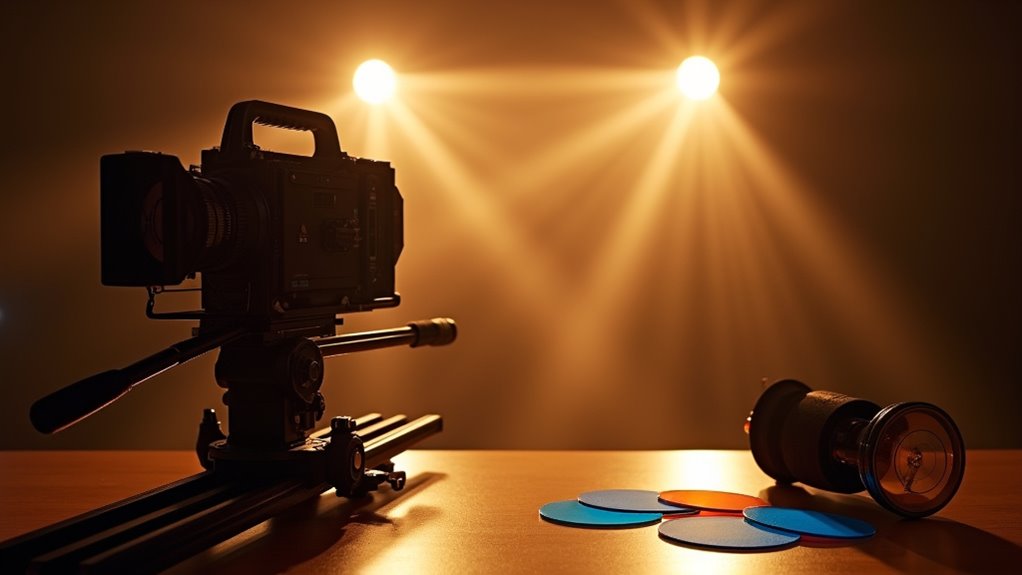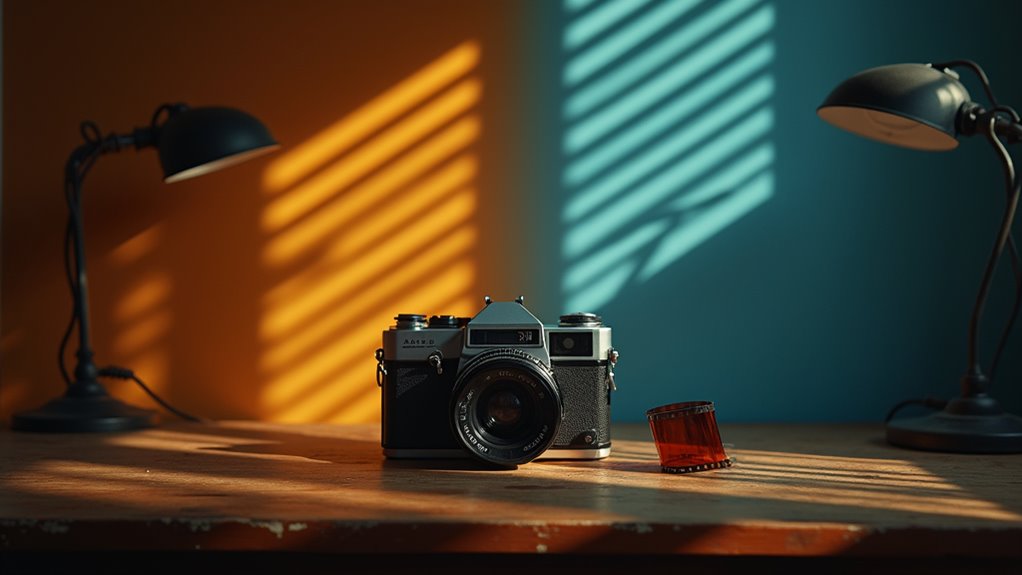Effective visual storytelling in cinema relies on mastering fundamental techniques while knowing when to break conventions. Directors employ strategic camera angles, lighting, and symbolism to craft narratives that resonate emotionally without relying on dialogue. Close-ups create intimacy, while dynamic movements maintain energy and flow. Sound design and carefully chosen visual motifs work together to bypass intellectual barriers and tap directly into viewers’ emotional cores. The journey into cinematic storytelling leads to endless creative possibilities.
Crafting Visual Language Through Camera and Light

The visual language of cinema speaks through an intricate dance of camera and light, where every frame tells a story beyond mere dialogue and action.
Directors wield camera angles like emotional paintbrushes, using high angles to diminish characters into vulnerable positions, while low angles transform ordinary figures into towering giants of authority, much like how Citizen Kane’s imposing shots defined cinematic power for generations. Close-up shots reveal intimate character emotions, creating powerful connections between viewers and the story being told.
Through the lens, we shape emotion itself, turning simple angles into powerful statements of dominance and vulnerability.
Sound effects complement the visual storytelling, adding layers of immersion that heighten emotional impact. The manipulation of light further shapes this visual narrative, with three-point lighting serving as the industry’s tried-and-true formula for creating depth and dimension. Warm colors can intensify scenes with heightened passion or energy, making viewers feel the emotional heat of dramatic moments.
When combined with dynamic camera movements, like the fluid grace of Steadicam shots or the sweeping drama of crane shots, these technical elements merge into a cohesive visual symphony.
Modern filmmakers often play with these conventions, using practical lighting sources and unconventional angles to craft unique visual signatures, proving that while rules exist to be mastered, they also exist to be cleverly broken.
Symbolism: The Silent Narrator in Film
Masterful visual storytelling relies on symbolism as cinema’s most subtle yet potent narrative force, weaving meaning through carefully chosen objects, colors, and motifs that speak volumes without uttering a word.
From the deeply layered symbolism of the scholar’s stone in “Parasite” to the mind-bending spinning top in “Inception,” these visual elements transform ordinary objects into powerful storytelling devices that resonate with audiences long after the credits roll.
Directors employ multiple symbolic layers, orchestrating a delicate dance of color, character, and plot symbolism that enriches the viewing experience. The key is maintaining seamless integration within the story’s natural flow. Effective symbolic elements create a deeper connection between viewers and the narrative. From groundbreaking films like *King Kong* to modern blockbusters, directors have leveraged practical effects alongside symbolism to enhance storytelling impact.
The blood-red hallways in modern horror films aren’t just aesthetic choices; they’re calculated decisions that tap into primal fears.
Similarly, when the Joker dons his infamous face paint, it’s not merely a costume but a representation of society’s descent into chaos.
These symbolic elements, when thoughtfully integrated, elevate films from mere entertainment to thought-provoking artistic statements.
Building Emotional Resonance Without Words

While symbolism speaks through metaphor and visual subtext, emotional resonance flows through cinema’s most primal channels – the unspoken language of human connection. Through masterful orchestration of visual and auditory elements, filmmakers can create profound emotional impact without uttering a single word.
The strategic interplay of lighting, color, and camera movement serves as cinema’s silent conductor, guiding viewers through emotional landscapes with surgical precision. A tight close-up on a character’s quivering lip, bathed in cool blue light, can convey more heartbreak than pages of dialogue. Like authors who craft vivid descriptions of settings in brief moments, filmmakers must capture the essence of a scene efficiently. Well-crafted cinematography techniques deliberately direct viewer attention to evoke specific emotional responses.
Meanwhile, the careful manipulation of sound design – from a haunting score to the deliberate absence of noise – amplifies these visual cues, creating a multisensory experience that bypasses intellectual barriers and strikes directly at the heart. Expert use of foley effects helps ground even the most fantastical scenes in a believable reality.
This wordless emotional vocabulary, when wielded by skilled storytellers, transforms simple scenes into powerful moments of human truth that resonate across cultural and linguistic boundaries.
Frequently Asked Questions
How Can Budget Constraints Affect Visual Storytelling Techniques in Independent Films?
Budget constraints push independent filmmakers to embrace resourceful visual storytelling through natural lighting, minimalist locations, and creative framing techniques.
Limited resources often spark innovative solutions, like using practical light sources, public spaces, and handheld cameras to create intimate narratives.
Smart visual metaphors and symbolic imagery help convey complex themes without expensive production elements, while thoughtful composition and color choices maximize storytelling impact despite financial restrictions.
What Software Tools Are Most Effective for Planning Visual Storytelling Elements?
Modern filmmakers rely heavily on Canva and Piktochart for initial visualization, while Katalist’s AI-powered storyboarding accelerates pre-production workflow.
For more sophisticated planning, Visme’s interactive features and Synthesia’s avatar-based previsualization offer robust solutions.
These tools, when combined with traditional software like Adobe Premiere Pro, create a comprehensive toolkit that transforms abstract concepts into tangible visual narratives, regardless of technical expertise.
How Do Cultural Differences Impact the Interpretation of Visual Storytelling Symbols?
Cultural differences fundamentally shape how audiences interpret visual symbols, with the same image carrying vastly different meanings across societies.
A white dove might represent peace in Western culture but symbolize death in parts of South Asia, while the color red signals danger in some contexts but prosperity in others.
Smart filmmakers navigate these cultural nuances by researching thoroughly and consulting cultural experts before incorporating symbolic elements.
When Should Directors Prioritize Practical Effects Over CGI in Visual Storytelling?
Directors should prioritize practical effects when physical authenticity enhances storytelling impact, particularly in intimate scenes requiring actor interaction or when budget constraints make CGI unrealistic.
While computer effects excel at large-scale spectacle, practical techniques often deliver superior results for tangible elements like creature effects, explosions, and period-specific details.
The choice ultimately depends on achieving the most convincing visual narrative while considering production resources and artistic vision.
How Can Smartphones Be Effectively Used for Professional-Quality Visual Storytelling?
Smartphones enable professional-quality visual storytelling through strategic use of native features and affordable accessories.
Directors can achieve cinematic results by leveraging high-resolution cameras, stabilization tools, and editing apps while following core filmmaking principles.
Shooting in 9:16 format for social platforms, utilizing external microphones for clear audio, and employing thoughtful composition techniques allows storytellers to create compelling content that rivals traditional production methods.
